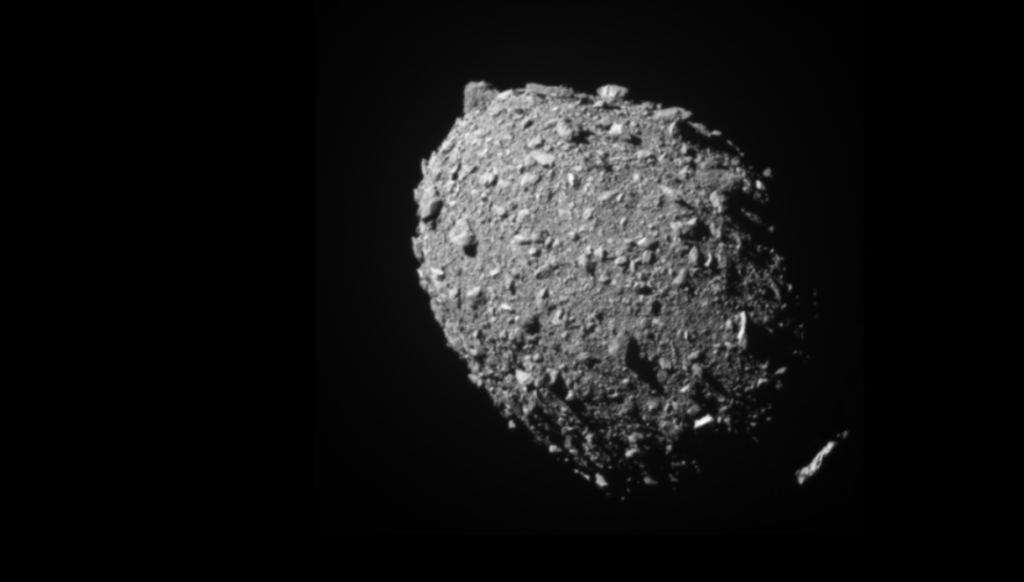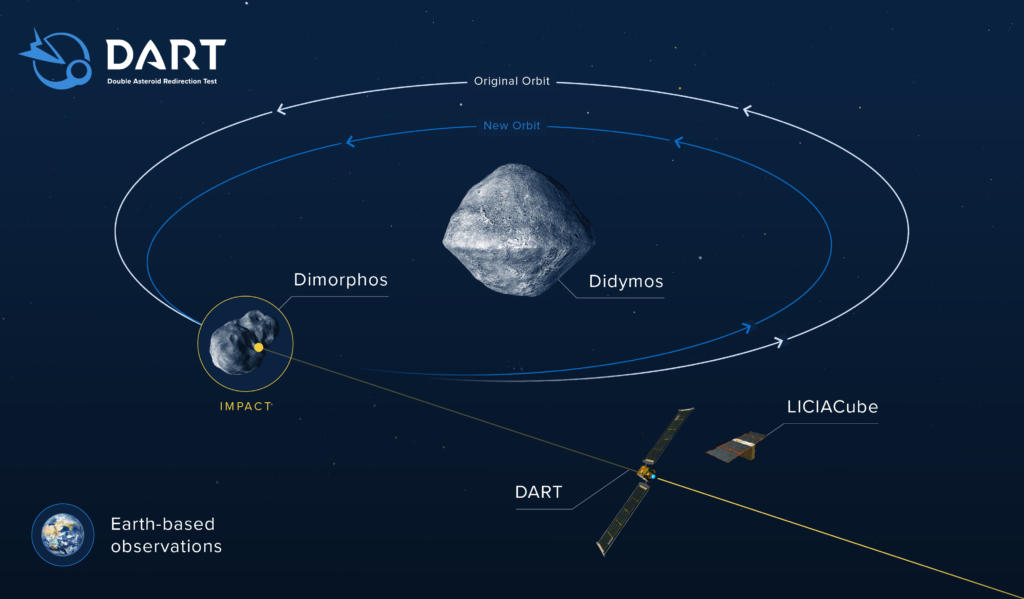
NASA Just Impacted An Asteroid With A Spacecraft
A very long time ago the dinosaurs were wiped out after a devastating asteroid impact. For years now NASA has been interested in the topic of planetary defense and specifically the thought of redirecting an asteroid if it were on a collision course with our planet. In order to answer questions, late last year the agency launched a spacecraft with the sole purpose of crashing into an asteroid.
Just yesterday, the spacecraft finally reached its destination and successfully impacted Dimorphos, the moon of the Didymos binary system. With this good news came a host of valuable data and incredible footage right before the spacecraft impacted the asteroid’s surface. The mission’s one-way trip confirmed NASA can successfully navigate a spacecraft to intentionally collide with an asteroid to deflect it, a technique known as kinetic impact.
With the impact now complete, NASA will watch very closely and figure out exactly how the crash has impacted the asteroid and its trajectory. This comes in addition to even more exciting footage expected to be released not long from now. Here I will go more in-depth into yesterday’s impact, what NASA knows so far, the overall mission, and more.
Yesterday’s Impact

After 10 months of flying in space, NASA’s Double Asteroid Redirection Test, or (DART), the world’s first planetary defense technology demonstration, successfully impacted its asteroid target on Monday, the agency’s first attempt to move an asteroid in space. Specifically, mission control at the Johns Hopkins Applied Physics Laboratory (APL) in Laurel, Maryland, announced the successful impact at 7:14 p.m. EDT. As a part of NASA’s overall planetary defense strategy, DART’s impact with the asteroid Dimorphos demonstrates a viable mitigation technique for protecting the planet from an Earth-bound asteroid or comet, if one were discovered.
DART targeted the asteroid moonlet Dimorphos, a small body just 530 feet (160 meters) in diameter. It orbits a larger, 2,560-foot (780-meter) asteroid called Didymos. NASA made it very clear that neither asteroid poses a threat to Earth. The spacecraft’s sole instrument, the Didymos Reconnaissance and Asteroid Camera for Optical navigation (DRACO), together with a sophisticated guidance, navigation and control system that works in tandem with Small-body Maneuvering Autonomous Real Time Navigation (SMART Nav) algorithms, enabled DART to identify and distinguish between the two asteroids, targeting the smaller body. These systems guided the 1,260-pound (570-kilogram) box-shaped spacecraft through the final 56,000 miles (90,000 kilometers) of space into Dimorphos, intentionally crashing into it at roughly 14,000 miles (22,530 kilometers) per hour to slightly slow the asteroid’s orbital speed. DRACO’s final images, obtained by the spacecraft seconds before impact, revealed the surface of Dimorphos in close-up detail. Here we watched mission control’s reaction as the spacecraft got closer and closer before losing signal meaning it had successfully impacted the surface.
While the spacecraft itself provided some incredible images, many people are likely wondering about the images from LICIACube. Fifteen days before impact, DART’s CubeSat companion Light Italian CubeSat for Imaging of Asteroids (LICIACube), provided by the Italian Space Agency, deployed from the spacecraft to capture images of DART’s impact and of the asteroid’s resulting cloud of ejected matter. In tandem with the images returned by DRACO, LICIACube’s images are intended to provide a view of the collision’s effects to help researchers better characterize the effectiveness of kinetic impact in deflecting an asteroid. NASA clarified that because LICIACube doesn’t carry a large antenna, images will be downlinked to Earth one by one in the coming weeks.
“DART’s success provides a significant addition to the essential toolbox we must have to protect Earth from a devastating impact by an asteroid,” said Lindley Johnson, NASA’s Planetary Defense Officer. “This demonstrates we are no longer powerless to prevent this type of natural disaster. Coupled with enhanced capabilities to accelerate finding the remaining hazardous asteroid population by our next Planetary Defense mission, the Near-Earth Object (NEO) Surveyor, a DART successor could provide what we need to save the day.” As of right now, with the asteroid pair within 7 million miles (11 million kilometers) of Earth, a global team is using dozens of telescopes stationed around the world and in space to observe the asteroid system. Over the coming weeks, they will characterize the ejecta produced and precisely measure Dimorphos’ orbital change to determine how effectively DART deflected the asteroid. The results will help validate and improve scientific computer models critical to predicting the effectiveness of this technique as a reliable method for asteroid deflection.
DART’s Importance

Now that we know more about yesterday’s impact, we can take a closer look at what NASA had to say regarding the successful mission, and what exactly it means for the future. “At its core, DART represents an unprecedented success for planetary defense, but it is also a mission of unity with a real benefit for all humanity,” said NASA Administrator Bill Nelson. “As NASA studies the cosmos and our home planet, we’re also working to protect that home, and this international collaboration turned science fiction into science fact, demonstrating one way to protect Earth.” The investigation team will now observe Dimorphos using ground-based telescopes to confirm that DART’s impact altered the asteroid’s orbit around Didymos. Researchers expect the impact to shorten Dimorphos’ orbit by about 1%, or roughly 10 minutes; precisely measuring how much the asteroid was deflected is one of the primary purposes of the full-scale test.
“Planetary Defense is a globally unifying effort that affects everyone living on Earth,” said Thomas Zurbuchen, associate administrator for the Science Mission Directorate at NASA Headquarters in Washington. “Now we know we can aim a spacecraft with the precision needed to impact even a small body in space. Just a small change in its speed is all we need to make a significant difference in the path an asteroid travels.”
To get a better idea of how this mission is applicable and how asteroids are found, tracked, and monitored, we can take a closer look at a few different programs. The current congressionally directed objective of the Near Earth Object or NEO Observations Program is to find, track, and characterize at least 90 percent of the predicted number of NEOs that are 140 meters and larger in size–larger than a small football stadium–and to characterize a subset representative of the entire population. Objects of this size and larger pose a risk to Earth of greatest concern due to the level of devastation an impact would cause, and should continue to be the focus of global search efforts. While no known asteroid larger than 140 meters in size has a significant chance to hit Earth for the next 100 years, less than half of the estimated 25,000 NEOs that are 140 meters and larger in size have been found to date. This being said, the NEO Observations Program sponsors projects that make use of telescopes around the world to search for NEOs, track them across the sky to determine their orbits, and gain information on their sizes, shapes, and composition.
The Minor Planet Center (MPC) is the internationally agreed-to public archive of small-body orbit data submitted by observers from around the world. The MPC notifies observers worldwide about NEO discoveries so that timely follow-up observations can be collected for identification, and orbit computation. The MPC is sanctioned by the International Astronomical Union and supported by the PDCO as a subnode of NASA’s Planetary Data System Small Bodies Node. From here, the Center for Near-Earth Object Studies (CNEOS) computes high-precision orbit paths for NEOs from positions reported to the Minor Planet Center. CNEOS computes orbits for new asteroid discoveries and performs long-term analyses of possible future positions of hazardous asteroids relative to Earth to determine and warn of any impact hazard. CNEOS computes impact time and location in the event of a predicted impact. The Jet Propulsion Laboratory hosts CNEOS for the NEO Observations Program, and its website makes all orbit computation public. With all this in mind, if an asteroid was found that was both significant in size and predicted to hit Earth, we would work to send a spacecraft similar to DART to impact and redirect the asteroid. Yesterday’s successful result was a very important first step in this process and the future of planetary defense.
Conclusion
Yesterday NASA officially impacted the Didymos asteroid with the DART spacecraft. In addition to some fascinating images leading up to the impact, the agency also gathered some invaluable data. Right now NASA is looking very closely at the asteroid to see how much of an impact this test had. This comes, in addition, to even more images from a separate camera expected to come out in the next few weeks. We will have to wait and see how it progresses and the impact it has on the space industry.
